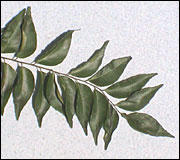
European's 1600's tasteless diet created the demand for spices to pep up the food in the 1600's. Many different spices were in demand including peppercorns, nutmeg and curry. This demand is what created spice trails and trading routes by ships.
Curry is really a mixture of spices and the curry plant is usually fried in hot oil or ghee (clarified butter for seasoning).
The curry is a fast growing deciduous shrub or small tree not to be confused with the curry plant, a with slivery curry scented leaves not for culinary use. The curry tree or shrub has different names depending on the location. In Dutch it is call ed Kerriebladeren, Spanish-Bignay, while in India it is call Kariapak, Katneem or neethi neem. The Sanskrit Scholars call it Hoja.
If you can find the pant or fresh cuttings you can grow the pant in a small pot in a container garden and then bring it inside during the winter. I have not personally grown this plant but I do have a curry plant, a plant in my herb garden used for its scent and color.
Curry Powder
Makes 5 to 6 tablespoons
2 tablespoons whole coriander seed
1 tablespoon cumin seeds
2 teaspoons peppercorns
1 1/2 teaspoons brown mustard seeds
5 whole cloves
2 to 3 hot red chilies, crumble
1 teaspoons fenugreek seeds
1 teaspoon ground turmeric
In a small cast iron pan on medium heat put the coriander seed, cumin seeds, peppercorn seeds, mustard seeds, cloves and chilies. Stir until light roasted aroma. Put in fenugreek seed and turmeric and stir for 10 seconds. Put toasted spice on a clean plate and let cool. Grind cooled spices in a coffee or spice grinder as finely as possible. Store in a jar away from heat and sunlight.
No comments:
Post a Comment
What Do You think?